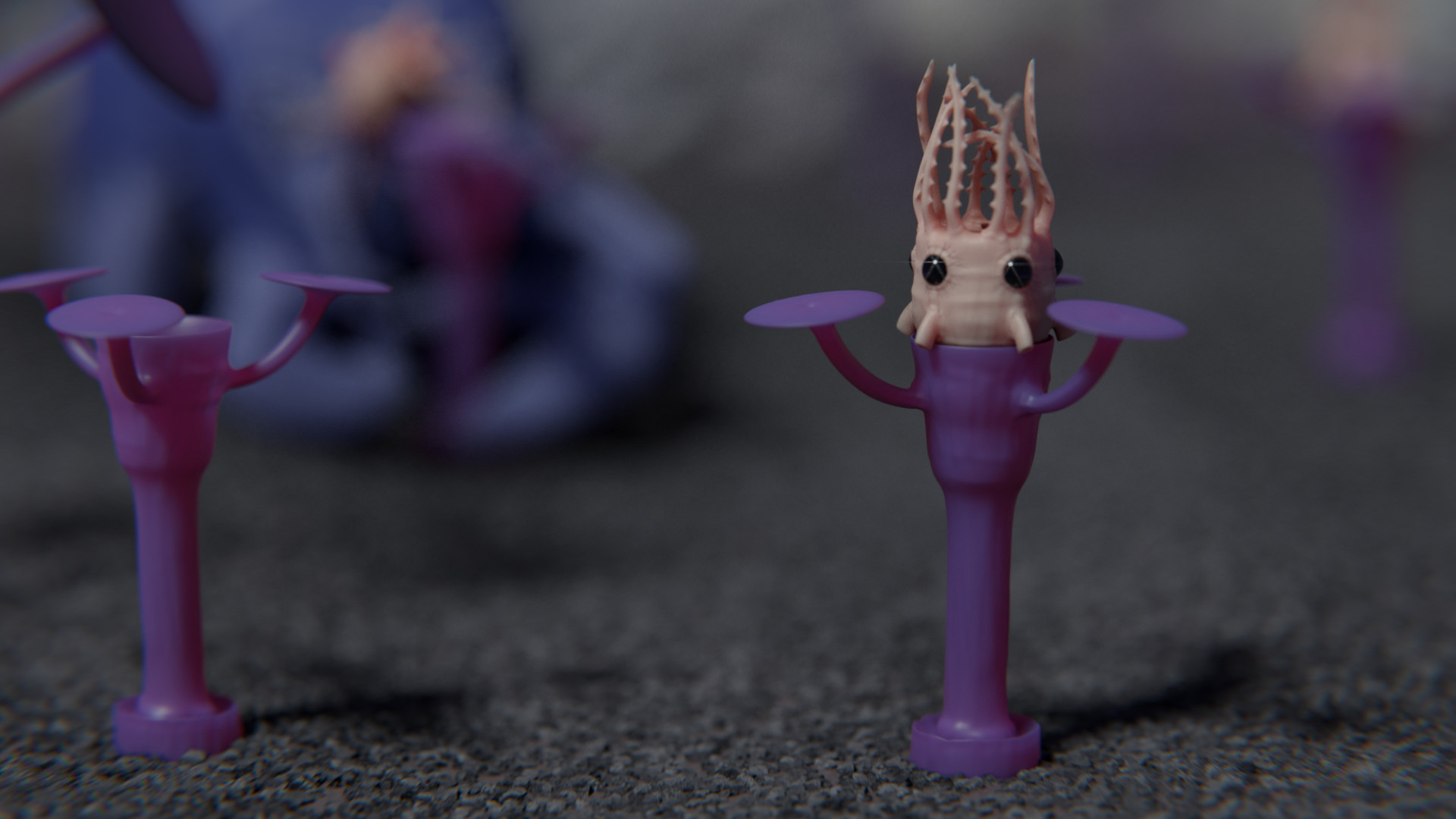Tube Barrel
The Tube Barrel is a symbiotic xenoradiatan, pictured with its symbiote, the purple pitcher plant. [Creature design by Raian Draggy]
Basic Information
Anatomy
Tube barrels are an example of neoteny. They never actually develop their lower appendages into the cement secreting form of an adult, and their respiro-reproductive tracts remain fully functional for locomotion. Otherwise, however the anatomy is fairly conservative, retaining all the major parts of the ancestral feather barrel, and all of them in essentially the same place as in its ancestor. The eyes are proportionally large, and have many potoreceptive cells, allowing for a high degree of visual accuity. Additionally the ganglion in each radial segment is quite large and extends laterally, they are all connected to each other by large nerve bundles protected by a thick layer of cartilage. This relatively advanced nervous system allows for complex coordination of the animal's lower appendages, respiro-genital organs, and feeding fronds on the top of its body, all of which are used for to coordinate its relatively complex behavior. The projections to either size of the feeding fronds are partially mineralized and are used to stab at threats.
Genetics and Reproduction
Tube barrels have two sexes, and reproduce via external fertilization. a cluster of eggs are placed at the center of the purple pitcher plant's "leaves" where spores are developing. Because the two species have evolved together for a few million years, they tend to produce similar numbers of eggs and spores. The spores and eggs adhere to each other, generally one to one, although sometimes other ratios occur. The tube barrel egg and the spore will drift to a new location together and assuming appropriate conditions they will start to grow together. If there is more than one spore attached to an egg the tube barrel will simply pick one as its host. If on the other hand more than one egg is attached to a spore the tube barrels will battle for dominance, with the loser generally swimming off. If it is lucky it may find an unguarded purple pitcher plant, but generally it will die.
Ecology and Habitats
Tube barrels can be found in many of the same places as Bosio magno stands, their hosts fulfill the roll of undergrowth in these areas, and are able to quickly fill in gaps in the coverage because they are infrequently consumed, as those who try get a face full of sharp feeding fronds from a surprisingly fierce xenoradiatan.
Dietary Needs and Habits
Tube barrels mostly eat microbes that are on the surface of their hosts, and the nutritive and sap that is exuded near the base of their hosts. While they are resting in their host's pitcher they will also snare any passing plankton that gets close enough to their feeding fronds to supplement their diet.
Additional Information
Geographic Origin and Distribution
These organisms can be found world wide in the epipelagic zone, only being excluded from the coldest areas around Arctica.
Average Intelligence
Tube barrels have surprisingly complex behavior. It's not quite fair to call them intelligent, but they have much more complicated nervous systems than most of their contemporaries. While they still act on instinct, this instinct is complex, and requires careful coordination.
Perception and Sensory Capabilities
The large eyes are rather sensitive, and due to consecutive bands of muscles around their perimiter their shape can be adjusted somewhat to change their focal length. They are also backed by a high concentration of photoreceptive cells, overall giving them some of the best sight at this point in Almaishah's history. The fronds are very sensitive to pressure and are chemoreceptors. The bottom appendages are somewhat sensitive to touch, although much less so than the feeding fronds.
Symbiotic and Parasitic organisms
The tube barrel lives in a symbiotic relationship with the purple pitcher plant. It feeds primarily on microbes or small parasites that would grow on it, as well as occasionally taking small amounts of a viscous secretion found near the base of that retinalphyte. In return the tube barrel viciously attacks anything, even things much larger than itself that approaches too near to its host, with the exception of other tube barrels.
EXTINCT
Genetic Ancestor(s)
Scientific Name
Fistuladolio iratus
Origin/Ancestry
Xenoradiata
Average Height
1.5" / 3.75 cm
Average Length
1" / 2.75 cm in diameter
Remove these ads. Join the Worldbuilders Guild











Comments